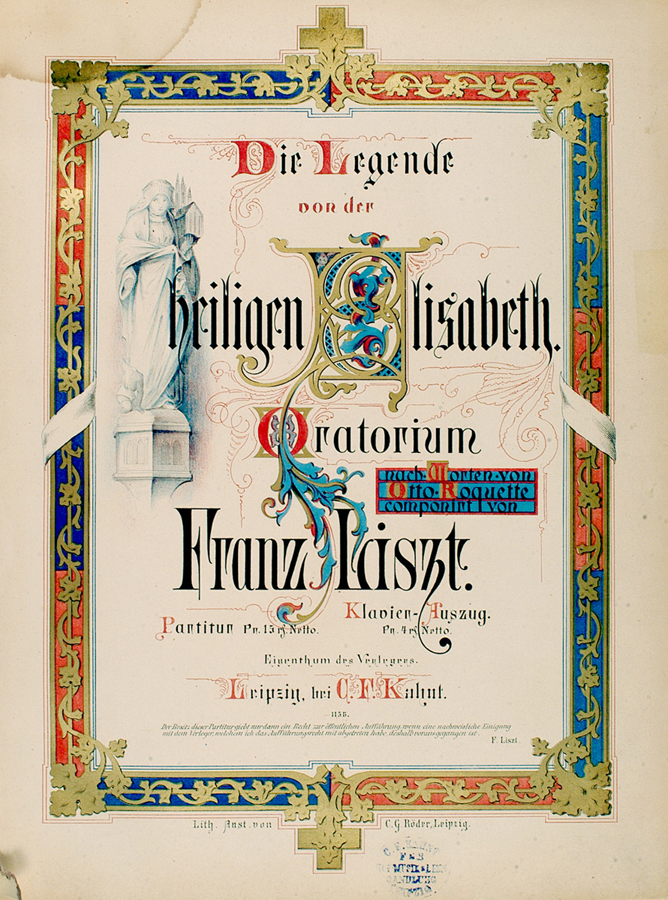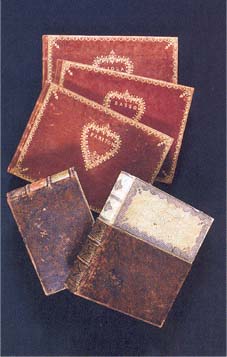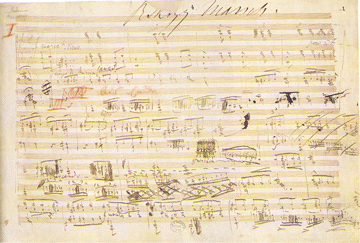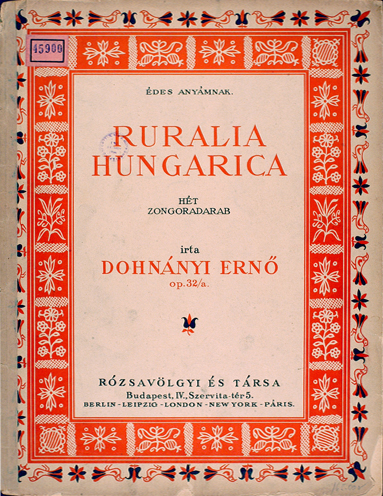
Music Collection
 Although the stock of National Széchényi Library had contained music documents since its foundation, the idea of setting up a separate Music Collection came up only at the beginning of the 20th century. Following the purchase of Ferenc Erkel’s heritage, which ended in the 1910s, first the so-called “Musica” division was formed within NSZL’s Manuscripts Archive, and then, in February 1924, Chief Librarian Kálmán Isoz, PhD was assigned to organize a proper Music Collection for Hungary’s National Library.
Although the stock of National Széchényi Library had contained music documents since its foundation, the idea of setting up a separate Music Collection came up only at the beginning of the 20th century. Following the purchase of Ferenc Erkel’s heritage, which ended in the 1910s, first the so-called “Musica” division was formed within NSZL’s Manuscripts Archive, and then, in February 1924, Chief Librarian Kálmán Isoz, PhD was assigned to organize a proper Music Collection for Hungary’s National Library.
NSZL’s current Music Collection comprises as many as 170,000 items of printed sheet music, while the number of manuscript sheet music items registered under code Ms. mus. is approximately 18,000. In addition to that, National Széchényi Library keeps a great number of manuscript- and printed sheet music in its repositories and its opera and stage music collection of the size of roughly 550 running meters of shelves. As accessory materials, Music Collection also keeps music-related photos, text manuscripts on the history and theory of music as well as several heritage collections of composers. It is important to know that items of manuscript sheet music written before the 16th century are stored by NSZL’s Manuscripts Archive, while printed sheet music made before the 18th century are kept by the Early Printed Books Archive.
 National Széchényi Library’s Music Collection includes several internationally renowned sub-collections.
National Széchényi Library’s Music Collection includes several internationally renowned sub-collections.
Comprising over seventy voice books, the archive of sheet music of Saint Egyed Church in the town of Bártfa (today’s Bardejoc in Slovak Republic) got into the possession of National Széchényi Library in the first decades of the 20th century. This archive gives an overall view of the rich international repertoire used in the cities of 16th-17th century Hungary.
Following World War II, the archive of sheet music, once belonging to the Esterházy princes, was acquired by NSZL. The archive makes our Music Collection the world’s richest collection of documents related to the life and works of Joseph Haydn. Not only does it contain Haydn’s approximately one-hundred manuscripts, one-time copies of his works and first editions, but the collection also comprises manuscript sources (amendments in Haydn’s own handwriting and some of his arias) of the Italian opera repertoire performed for Miklós “Bright” in the Opera House at Eszterháza, together with the archives Acta musicalia illustrating music life at Esterházy Court. The archive of sheet music also includes works by outstanding composer contemporaries such as Gregor Joseph Werner, Michael Haydn, Johann Georg Albrechtsberger, Karl Ditters von Dittersdorf or Franz Xaver Süssmayr. NSZL’s virtual exhibition entitled Seven Times Haydn gives you a hint how rich our Haydn collection is.
 Out of the author’s manuscripts of Ferenc Liszt, National Széchényi Library owns some fifty items, together with a number of correction copies, printed sheet music and letters bearing the famous composer’s handwriting. Letters written by Liszt can be found by NSZL’s readers in the Manuscripts Archive, too.
Out of the author’s manuscripts of Ferenc Liszt, National Széchényi Library owns some fifty items, together with a number of correction copies, printed sheet music and letters bearing the famous composer’s handwriting. Letters written by Liszt can be found by NSZL’s readers in the Manuscripts Archive, too.
The rich heritage of Erkel Ferenc was purchased by National Széchényi Library in the beginning of the 20th century, so today you can study the author’s manuscripts of all of Erkel’s operas in our Music Collection. Another part of the heritage (letters and other manuscript materials) can be studied in the Library’s Manuscript Archive. In 2010, on the occasion of the bicentenary of Ferenc Erkel’s birth, NSZL purchased the heritage of Gyula Erkel, son and fellow-composer of Ferenc Erkel, too. Currently, this material is under processing.
Quite a few of the most important documents of this rich collection can be accessed free on the continuously developing Erkel site of National Széchényi Library.
In addition to the above-mentioned Erkel and Liszt documents, NSZL keeps a rich source material on other outstanding figures of Hungarian music life in the 19th century, too. In our Reading Room, you can study most of the works by János Bihari, János Lavotta, Antal Csermák, Márk Rózsavölgyi, Gábor Mátrai (Rótkrepf) and Béni Egressy, just to mention a few. In NSZL’s Music Collection, you can also find the majority of music manuscripts and first editions of works by Mihály Mosonyi and the author’s heritage of Károly Huber, Imre Székely and Mór Vavrinecz. The document collection related to Károly Goldmark’s oeuvre is also of international significance.
 Even richer is our collection highlighting the oeuvre of 20th century Hungarian composers. Especially fascinating is the heritage material related to Ernő Dohnányi but in the NSZL you can also study the musical bequests related to, among others, Zoltán Horusitzky, Jenő Hubay, István Kerner, Sándor Jemnitz, Pongrác Kacsóh, Tibor Kazacsay, György Kerényi, Aurél Kern, Gyula Kiszely, Rezső Kókay, Tibor Pikéthy, Béla Reinitz, Sándor Reschofsky, Albert Siklós, Ferenc Szabó, Xavér Ferenc Szabó, István Szelényi, Endre Székely, Géza Csáth, Ferenc Farkas and Imre Fábián.
Even richer is our collection highlighting the oeuvre of 20th century Hungarian composers. Especially fascinating is the heritage material related to Ernő Dohnányi but in the NSZL you can also study the musical bequests related to, among others, Zoltán Horusitzky, Jenő Hubay, István Kerner, Sándor Jemnitz, Pongrác Kacsóh, Tibor Kazacsay, György Kerényi, Aurél Kern, Gyula Kiszely, Rezső Kókay, Tibor Pikéthy, Béla Reinitz, Sándor Reschofsky, Albert Siklós, Ferenc Szabó, Xavér Ferenc Szabó, István Szelényi, Endre Székely, Géza Csáth, Ferenc Farkas and Imre Fábián.
The Music Collection of National Széchényi Library keeps Péter Szőke’s musical-ornithological and István Volly’s folk music collections. (The latter contains 60 phonograph cylinders, the digitized versions of which can be accessed online as well.)
The Theater Music Collection of the Library has been documenting the musical material of stage productions in the repertoire of municipal and rural theaters since around the 1830s. In the archive of more than 550 running meters of shelves, one can find the historical sheet music collections of Népszínház (Folk Theater), Nemzeti Színház (National Theater) and Magyar Királyi Operaház (Hungarian Royal Opera House). The archive gives an overall view of the development of Hungarian musical stage productions, in genres such as folk play, operetta and opera.
In addition to sheet music, NSZL’s Music Collection collects sound recordings as well. Our sound archive is relatively young, but it now represents a significant part of our holdings, which has grown through legal deposit since 1957, as well as through purchases and valuable donations. Today, it comprises some 100,000 documents ranging from phonograph cylinders to 78 rpm discs, LPs, tape cassettes and CDs. The vast majority of these recordings are commercially released sound recordings, but they also include unique recordings such as Andor Földes’ radio recordings, Péter Szőke’s collection of birdsong recordings on tape or István Volly’s folk music phonograph cylinders.
Our sound collection includes not only music but also various spoken word recordings, currently more than 2,000 items. Of particular importance are the two phonograph cylinders that recorded Lajos Kossuth’s speech delivered at the unveiling of the monument dedicated to the Martyrs of Arad. This recording, made in September 1890, can be accessed freely on our website.
The prestigious collection of gramophone records, one of the most important in the country, was built up in the first decades of the 21st century, largely due to the National Library’s conscious acquisition policy, with the acquisition of three of the most important private collections in Hungary. Around the turn of the millennium, the institution acquired the József Kovács Collection of 10,000 records, it received the Marton-Bajnai Collection of 45,000 records as a gift in 2014, and finally, in the late 2010s, it purchased the collection of around 10,000 records of Zoltán Kiss Gábor. (These ones have also significantly enriched our vinyl record collection.) A selection of the already processed and digitized archival sound documents are available in the database entitled Hangtár (Sound Library).



